1. The True Origin of 'Allah':
The Archaeological Record Speaks
A. The Name of God in the Bible
The God of the Old Testament is known as YHWH ( )or, when pointed with the correct vowels, Yahweh. This translates as "The Self-Existent One", being derived from the Hebrew Yháwáh, meaning "to exist". As Allah is the name of God on the Muslim Holy Scriptures, the Koran (or Quran), so Yahweh is the Name of God in the Hebrew Scriptures, the Bible. What is particularly interesting and significant is the fact that Yahweh never appears as the name of of any deity outside the Bible. There is no record anywhere of any other tribe or religion which worhipped Yahweh. The Hebrew Name of God is unique to the Bible and its chosen people. From this alone we may deduce that the Name "Yahweh" was not borrowed from some other culture or religion. It emerged unquely within the Bible revelation.
)or, when pointed with the correct vowels, Yahweh. This translates as "The Self-Existent One", being derived from the Hebrew Yháwáh, meaning "to exist". As Allah is the name of God on the Muslim Holy Scriptures, the Koran (or Quran), so Yahweh is the Name of God in the Hebrew Scriptures, the Bible. What is particularly interesting and significant is the fact that Yahweh never appears as the name of of any deity outside the Bible. There is no record anywhere of any other tribe or religion which worhipped Yahweh. The Hebrew Name of God is unique to the Bible and its chosen people. From this alone we may deduce that the Name "Yahweh" was not borrowed from some other culture or religion. It emerged unquely within the Bible revelation.
It is claimed by Muslims that Allah is the God of the Bible and that he is mentioned in the sacred texts. This is absolutely not true. The name "Allah" does not appear once in either the Old or New Testaments. The only time God is referred to by name in the Old Testament is either as YAHWEH (meaning "He (who) is") or as a contraction, YAH. [Please note that the name "Jehovah" is not a biblical name of God but was especially 'created' by Jews afraid to pronounce the Sacred Name by combining the consonants YHWH with the vowels from adonai, meaning "Lord"].
The word allah does exist in Hebrew but it is not a proper name and it never refers to God. It has three principal meanings: (a) to curse, swear, or adjure; (b) to lament (weep); and (c) to arise, ascend, climb, go away, leap, etc.. It is an indisputable fact that ALLAH does not appear even once as the Name of God, or even of a man, in the Hebrew Scriptures. There is no word 'alah' or 'allah' in the Greek New Testament at all. It was, quite simply, unknown in the Bible world. To therefore claim that 'Allah' was the name of God in the Bible is without one single shred of evidence. God has always been known as Yahweh, or (much less frequently) by the contraction Yah.
Muslim scholars have gone to great lengths to try and prove that the Arabic "Allah" is, in fact, the same as the Hebrew "Eloah", which is not a proper name and simply translates as "God". The words "El" and "Elohim" also translate the same way, appear far more numerously than Eloah, and may be used to designate either the true God, pagan deities, idols, or even human judges. It is for this reason that I have heard Muslim apologists get annoyed when other Muslins talk about "God" instead of "Allah" because the word "God" can be applied to any religion's god. They recognise that Allah is a proper name which distinguishes the God of the Muslims from the God of the Jews and Christians, or the gods of the Hindus and others. "Eloah" is, in any case, a derivative of "El" and its plural "Elohim" which doesn't remotely sound like "Allah". You will not find many (if any) Muslims insisting that they worship the Hebrew Eloah - the only time they ever try to make a connection is when trying to recruit Jews and Christians to Islam. If I were confess that "Eloah" were my God and that Mohammed was his prophet I doubt any Muslim would believe I had converted to Islam!
There is another El-derived word for "God" in the Old Testament which sounds similar to Allah and that is Elah. It is only used by the prophets Ezra, Daniel and once by Jeremiah. It is, again, not a proper name, and actually also means an "oak tree" and was thus also used by pagans as a title for their tree deities, i.e. idols. I doubt somehow that Muslims would wish their Allah to be associated with an idol.
Even if the Muslim scholars were right about "Eloah" (which the evidence strongly repudiates) we would then be faced with the problem that God has two proper names - Yahweh and Eloah/Allah - which contradicts God's own testimony in the Old Testament that He is only known as Yahweh.
The Name Yahweh is enshrined in the Third Commandment:
The word "vain" is the Hebrew shoaw, meaning "to rush over, to bring devastation, uselessness, or ruin". In other words, this is THE Sacred Name above all names. This Name is not to be blasphemed (Lev.24:16) or desicrated. It is to be treated with reverential awe because it is the essence of the True God Himself.
The Catholics and most Protestants have blasphemed this Name by changing it to "Jehovah" which translated "God is perverse" by mutilating it (as described above). There is even a whole church called the "Jehovah's Witnesses" which uses this disgusting name. The Bible teaches from cover to cover that the true Name of God, Yahweh, is essential to salvation. It is mentioned right at the beginning of the Bible and is used througout. Yahweh is the creator "who made the earth and the heavens" (Gen.2:4).
You see, God's true Name was even preserved in the Name of the Messiah because it is YAH / Yahweh - who saves. The Name of "Jesus" was "YAHWEH SAVES".
The Scriptures are therefore consistent not only in preserving the true Name of God, Yahweh (YAWH), throughout, but in placing the Sacred Name in the Messiah as well. This is no accident of immense prophetic significance. There are now millions of believers who now no longer use the perverse name "Jehovah" and who use the correct name of Jesus, Yah'shua, in order to be true to the Scriptures.
As its roots lie in the name Isho in Aramaic and Yeshua in Hebrew, it is etymologically related to another biblical name, Joshua. We need to give consideration also that the New Testament was translated in Greek.
Christ is the English term for the Greek Χριστός (Khristós) meaning "the anointed one". It is a translation of the Hebrew מָשִׁיחַ (Māšîaḥ), usually transliterated into English as Messiah or Mashiach.
What has this to do with our discussion of Allah? The reason I have spent so much time underscoring the Biblical Name of God is to show clearly and finally that it has been known as Yahweh since the beginning of time. And there are certain superficial similarities in sound to the Arabic "Allah" the meaning and historical origin is quite, quite different.
B. Origin of the Name Allah
The word "Allah" comes from the compound Arabic word, al-ilah. Al is the definite article "the" and ilah is an Arabic word for "god", i.e. the god. We see immediately that (a) this is not a proper name but a generic name rather like the Hebrew El (which as we have seen was used of any deity; and (b) that Allah is not a foreign word (as it would have been if it had been borrowed from the Hebrew Bible) but a purely Arabic one. It would also be wrong to compare "Allah" with the Hebrew or Greek for God (El and Theos, respectively), because "Allah" is purely an Arabic term used exclusively in reference to an Arabic deity.
The Encyclopedia of Religion says: "'Allah' is a pre-Islamic name ... corresponding to the Baylonian Bel" (ed. James Hastings, Edinburgh, T. & T. Clark, 1908, I:326).
I know that Muslims will find this hard to believe so I am now going to make many citations and present the archaeological evidence to prove conclusively that is true. Though this data will be painful for many of our readers, it is necessary to face the truth. Facts are facts, and unless you are willing to desert all logic, reason and common sense, and the evidence of your eyes, they must be faced.
- "Allah is found ... in Arabic inscriptions prior to Islam" (Encyclopedia Britannica, I:643)
- "The Arabs, before the time of Mohammed, accepted and worshipped, after a fashion, a supreme god called allah" (Encyclopedia of Islam, eds. Houtsma, Arnold, Basset, Hartman; Leiden: E.J.Brill, 1913, I:302)
- "Allah was known to the pre-Islamic Arabs; he was one of the Meccan deities" (Encyclopedia of Islam, ed. Gibb, I:406)
- "Ilah ... appears in pre-Islamic poetry ... By frequency of usage, al-ilah was contracted to allah, frequently attested to in pre-Islamic poetry" (Encyclopedia of Islam, eds. Lewis, Menage, Pellat, Schacht; Leiden: E.J.Brill, 1971, III:1093)
- "The name Allah goes back before Muhammed" (Encyclopedia of World Mythology and Legend, "The Facts on File", ed. Anthony Mercatante, New York, 1983, I:41)
- The origin of this (Allah) goes back to pre-Muslim times. Allah is not a common name meaning "God" (or a "god"), and the Muslim must use another word or form if he wishes to indicate any other than his own peculiar deity" (Encyclopedia of Religion and Ethics, ed. James Hastings, Edinburgh: T & T Clark, 1908, I:326)
Scholar Henry Preserved Smith of Harvard University stated:
- "Allah was already known by name to the Arabs" (The Bible and Islam: or, the Influence of the Old and New Testament on the Religion of Mohammed, New York: Charles Scribner's Sons, 1897, p.102)
Dr. Kenneth Cragg, former editor of the prestigious scholarly journal Muslim World and an outstanding modern Western Islamic scholar, whose works were generally published by Oxford University, comments:
- The name Allah is also evident in archaeological and literary remains of pre-Islamic Arabia" (The Call of the Minaret, New York: OUP, 1956, p.31)
Dr. W. Montgomery Watt, who was Professor of Arabic and Islamic Studies at Edinburgh University and Visiting Professor of Islamic Studies at College de France, georgetown University, and the University of Toronto, has done extensive work on the pre-Islamic concept of Allah. He concludes:
"In recent years I have become increasingly convinced that for an adequate understanding of the career of Muhammad and the origins of Islam great importance must be attached to the existence in Mecca of belief in Allah as a "high god". In a sense this is a form of paganism, but it is so different from paganism as commonly understood that it dererves separate treatment" (Mohammad's Mecca, p.vii. See also his article, "Belief in a High God in pre-Islamic Mecca", Journal of Scientific Semitic Studies, vol.16, 1971, pp.35-40)
Caesar Farah in his book on Islam concludes his discussion of the pre-Islamic meaning of Allah by saying:
"There is no reason, therefore, to accept the idea that Allah passed to the Muslims from the Christians and Jews" (Islam: Beliefs and Observations, New York: Barrons, 1987, p.28)
According to Middle East scholar E.M.Wherry, whose translation of the Koran is still used today, in pre-Islamic times Allah-worship, as well as the worship of Baal, were both astral religions in that they involved the worship of the sun, the moon, and the stars (A Comprehensive Commentary on the Quran, Osnabrück: Otto Zeller Verlag, 1973, p.36).
"In ancient Arabia, the sun-god was viewed as a female goddess and the moon as the male god. As has been pointed out by many scholars as Alfred Guilluame, the moon god was called by various names, one of which was Allah (op.cit., Islam, p.7)
"The name Allah was used as the personal name of the moon god, in addition to the other titles that could be given to him.
"Allah, the moon god, was married to the sun goddess. Together they produced three goddesses who were called 'the daughters of Allah'. These three goddesses were called Al-Lat, Al-Uzza, and Manat.
"The daughters of Allah, along with Allah and the sun goddess were viewed as "high" gods. That is, they were viewed as being at the top of the pantheon of Arabian deities" (Robert Morey, The Islamic Invasion, Eugene, Oregon, Harvest House Publishers, 1977, pp.50-51).
The Encyclopedia of World Mythology and Legend records:
"Along with Allah, however, they worshipped a host of lesser gods and "daughters of Allah" (op.cit., I:61).
It is a well known fact archaeologically speaking that the cresent moon was the symbol of worship of the moon god both in Arabia and throughout the Middle East in pre-Islamic times. Archaeologists have excavated numerous statues and hieroglyphic inscriptions in which a crescent moon was seated on the top of the head of the deity to symbolise the worship of the moon-god. Interestingly, the moon was generally worshipped as a female deity in the Ancient Near East, the Arabs viewed it as a male deity.
In Mesopotamia the Sumerian god Nanna, named Sîn by the Akkadians, was worshipped in particular in Ur, where he was the chief god of the city, and also in the city of Harran in Syria, which had close religious links with Ur. The Ugaritic texts have shown that there a moon deity was worshipped under the name yrh. On the monuments the god is represented by the symbol of the crescent moon. At Hazor in Palestine a small Canaanite shrine of the late Bronze Age was discovered which contained a basalt stele depicting two hands lifted as if in prayer to a crescent moon, indicating that the shrine was dedicated to the moon god.
The worship of stellar deities, instead of Yahweh, was always a temptation faced by the Israelites (Dt.4:19; Jer.7:18; Am.5:26; Ac.7:43). But Yahweh is at the zennith of the heavens (Job 22:12).
"The Quraysh tribe into which Mohammad was born was particularly devoted to Allah, the moon god, and especially to Allah's three daughters who were viewed as intercessors between the people and Allah.
"The worship of the three goddesses, Al-Lat, Al-Uzza, and Manat, played a significant rôle in the worship at the Kabah in Mecca. The first two daughters of Allah had names which were feminine forms of Allah.
"The literal Arabic name of Muhammad's father was Abd-Allah. His uncle's name was Obied-Allah. These names reveal the personal devotion that Muhammad's pagan family had to the worship of Allah, the moon god" (op.cit., Morey, p.51).
History proves conclusively that before Islam came into existence, the Sabbeans in Arabia worshipped the moon-god Allah who was married to the sun-goddess. We have also seen that it was a matter of common practice to use the name of the moon-god in personal names in Muhammad's tribe. That Allah was a pagan deity in pre-Islamic times is incontestible. And so we must ask ourselves the question: why was Muhammad's God named after a pagan deity in his own tribe?
It is an undeniable fact that an Allah idol was set up at the Kabah along with all the other idols of the time. The pagans prayed towards Mecca and the Kabah because that is where their gods were stationed. It made sense to them to face in the direction of their god and pray since that is where he was. Since the idol of their moon god, Allah, was at Mecca, they prayed towards Mecca.
As we have seen, and as is acknowledged amongst all scholars of Middle Eastern religious history, the worship of the moon-god extended far beyond Allah-worship in Arabia. The entire fertile crescent was involved in moon-worship. The data falls neatly in place and we are able therefore to understand, in part, the early success Islam had amongst Arab groups that had traditionally worshipped Allah, the moon-god. We can also understand that the use of the crescent moon as the symbol of Islam, and which appears on dozens of flags of Islamic nations in Asia and Africa, and surmounts minerets and mosque roofs, is a throwback to the days when Allah was worshipped as the moon-god in Mecca.
Educated Muslims understand these facts only too well - better, in fact, than most Christians. Robert Morey recalls a conversation he once had:
"During one trip to Washington DC I got involved in a conversation with a Muslim taxi driver from Iran. When I asked him, 'Where did Islam obtain its symbol of the crescent moon?' he responded that it was an ancient pagan symbol used throughout the Middle East and that adopting this symbol had helped Muslims to convert people throughout the Middle East. When I pointed out that the word Allah itself was used by the moon-god cult in pre-Islamic Arabia, he agreed that this was the case. I then pointed out that the religion and the Quran of Muhammad could be explained in terms of pre-Islamic culture, customs, and religious ideas. He agreed with this! He went on to explain that he was a university-educated Muslim who, at this point in his life, was attempting to understand Islam from a scholarly viewpoint. As a result, he had lost his faith in Islam. The significance of the pre-Islamic source of the name Allah cannot be overestimated" (op.cit., pp.52-53).
What is particularly interesting to me personally is seeing the parallels between the evolution of Islam and the Roman Catholic Church, both of which absorbed pagan ideas in order to make converts. Muhammad was not alone in his plagiarisation of other religions. Bogus "Christian" churches have done it too. Those naming the Name of Christ must accept responsibility for similar things. And it is for this reason that this author has renounced all counterfeit forms of Christianity and returned to the original teachings of the Bible and to the true God, Yahweh-Elohim.
If there is one thing that has been abundantly clear in my study of comparative religions it is this: all the major religions have different concepts of deity. Yahweh, Allah, Vishnu and Buddha are absolutely not the same. In other words, all religions do not worship the same God, only under different names. That is why the use of the word "God" in describing deity is so inadequate and why we must return to the names of these deities to discover what they actually mean in terms of personality and attributes. Ignoring the essential differences which divide world religions is an insult to the uniqueness of world religions. Yahweh, the God of the Bible, is not Allah the god of the Koran, is not Vishnu the god of the Vedas, is not the god of the Buddhists, etc.. As we shall see in a later article, there are fundamental differences between Yahweh and Allah in terms of personal attributes, theology, morals, ethics, soteriology, eschatology, theocracy, and in almost every other respect. They represent two different spiritual worlds. And when we discover even more of the nature of Yahweh through the revelation of Yah'shua (Jesus) we see that the gap between the Bible and the Koran is even wider.
I shall conclude this article with more evidence concerning the true origin of the deity which has been incorporated into Islam as Allah.
C. Archaeology of the Moon-God
Muslims worship a deity called Allah and claim that the Allah in pre-Islamic times was the biblical God, Yahweh, of the patriarchs, prophets, and apostles.
Ahmed Deedat, well-known Muslim apologist, argues that Allah is a biblical name for God on the basis of "Allelujah" which he convolutes into "Allah-lujah" (What is His Name?, Durban, SA: IPCI, 1990, p.37). This only reveals that he does not understand Hebrew, for haleluyah is the contracted form of Yahweh, YAH, preceeded by the verb "to praise" (literally, Praise Yah(weh)!). His other "biblical" arguments are equally absurd. He also claims that the word "Allah" was never corrupted by paganism. "Allah is a unique word for the only God ... you cannot make a feminine of Allah", says Deedat. But what he does not tell his readers is that one of Allah's daughters was named "Al-Lat", which is the feminine form of "Allah"!
The issue here is therefore seen to be one of CONTINUITY for the Muslim's claim of continuity (from Judaism to Christianity to Islam) is essential in their attempt to convert Jews and Christians. If "Allah" is part of the flow of divine revelation in Scripture, then it is the next step in biblical religion. Thus we should all become Muslims. But, on the other hand, if Allah was a pre-Islamic pagan deity, then its core claim is refuted.
Religious claims often come to grief as a result of solid scientific, archaeological evidence. So, instead of endlessly speculating about the past, we can look to science to see what the evidence reveals. As we shall see, the hard evidence demonstrates that the god Allah was a pagan deity. In fact, he was the moon-god who was married to the sun-goddess and the stars were his daughters.
Archaeologists have uncovered temples to the moon-god throughout the Middle East. From the mountains of Turkey to the banks of the Nile, the most widespread religion of the ancient world was the worship of the moon-god. It was even the religion of the patriarch Abraham before Yahweh revealed Himself and commanded him to leave his home in Ur of the Chaldees and migrate to Canaan.
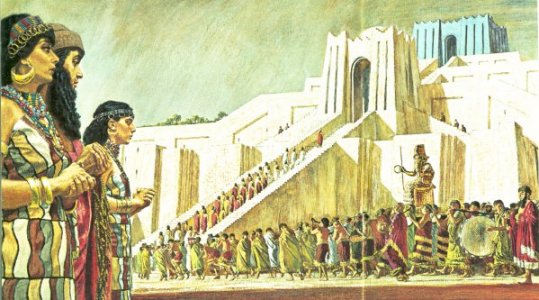 A scene from the time of Abraham. A merchant, his wife and daughter at the ziggurat of Ur, prayerfully watching parading
A scene from the time of Abraham. A merchant, his wife and daughter at the ziggurat of Ur, prayerfully watching parading
priests and musicians restore a gilded statue of the moon-god Sîn to his temple atop the "Hill of Heaven"
Archaeologists have uncovered temples to the moon-god throughout the Middle East (see the artistic reconstruction above based on museum artifacts, wall paintings found in ruined cities, etc. in ancient Mesopotamia). From the mountains of Turkey to the banks of the Nile, the most widespread religion of the ancient world was the worship of the moon-god.
The Sumerians, in the first literate civilisation, left thoudands of clay tablets describing their religious beliefs. As demonstrated by Sjöberg and Hall, the ancient Sumerians worshipped a moon-god who was called by many different names. The most popular names were Nanna, Suen, and Asimbabbar (Mark Hall, A Study of the Sumerian Moon-god, Sin, PhD., 1985, University of Pennsylvania). His symbol was the crescent moon. Given the amount of artifacts concerning the worship of this moon-god, it is clear that this was the dominant religion in Sumeria. The cult of the moon-god was the most popular religion throughout ancient Mesopotamia. The Assyrians, Babylonians, and Arkkadians took the word Suen and transformed it into the word Sîn as their favourite name for this deity (Austin Potts, The Hymns and Prayers to the Moon-god, Sin, PhD., 1971, Dropsie College, p.2). As Professor Potts pointed out, "Sîn is a name essentially Sumerian in origin which had been borrowed by the Semites" (op.cit., p.4).
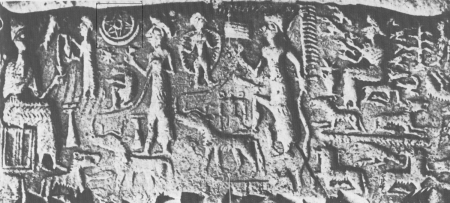 Anatolian mural from Karum - notice the boxed pre-Islamic Crescent-and-Star glyph
Anatolian mural from Karum - notice the boxed pre-Islamic Crescent-and-Star glyph
 Another pre-Islamic crescent moon and star from the same location
Another pre-Islamic crescent moon and star from the same location
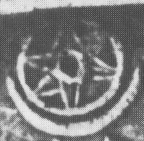

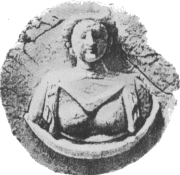 Pre-Islamic and Islamic Crescent-and-Star GlyphsAnatolian (left), Islamic (centre), Ancient Persian Moon-goddess (right)
Pre-Islamic and Islamic Crescent-and-Star GlyphsAnatolian (left), Islamic (centre), Ancient Persian Moon-goddess (right)
In ancient Syria and Canna, the moon-god Sîn was usually represented by the moon in its crescent phase. At times, the full moon was placed inside the crescent moon to emphasise all the phases of the moon. The sun-goddess was the wife of Sîn and the stars were their daughters. For example, Ishtar was the daughter of Sîn (Ibid., p.7).
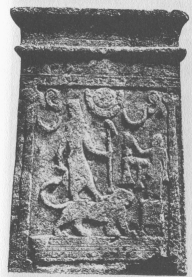
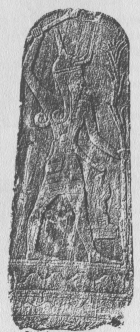 Sacrifices to the moon-god are described in the Ras Shamra texts (see Ras Shamra stele from North Syria to the right). In the Ugaritic texts, the moon-god was sometimes called Kusuh. In Persia (above right), as well as in Egypt (left), the moon-god is depicted on wall murals and on the heads of statutes. He was the judge of men and gods.
Sacrifices to the moon-god are described in the Ras Shamra texts (see Ras Shamra stele from North Syria to the right). In the Ugaritic texts, the moon-god was sometimes called Kusuh. In Persia (above right), as well as in Egypt (left), the moon-god is depicted on wall murals and on the heads of statutes. He was the judge of men and gods.
As a matter of fact, everywhere in the ancient world the symbol of the crescent moon can be found on seal impressions, steles, pottery, amulets, clay tablets, cylinders, weights, earrings, necklasses, wall murals, and so on. In Tell-el-Obeid, a copper calf was found with crescent moon on its forehead, the same idol the children of Israel worshipped in the Desert of Sîn (Sînai) during the apostacy Moses was on top of the mountain getting the Ten Commandments from Yahweh. While God's prophet (Moses) was conversing with the true God, Yahweh, the Israelites were descending into idolatry worshipping the moon-god, Sîn! An idol with the body of a bull and the head of a man has a crescent inlaid on its forehead with shells. In Ur, the Stela of Ur-Nammu has the crescent symbol placed at the top of the register of gods because the moon god was the head of the gods. Even bread was baked in the form of a crescent as an act of devotion to the moon-god (Ibid, pp.14-21).
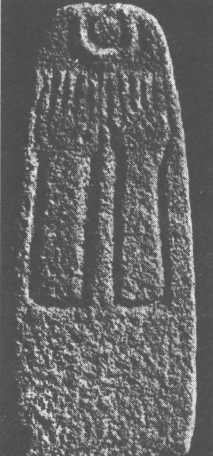
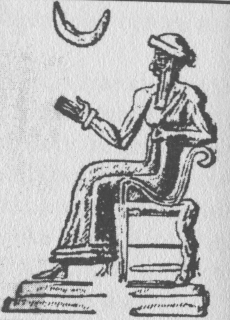 Ur of the Chaldees was so devoted to the moon-god that it was sometimes called Nannar in tablets from that time period. A temple of the moon-god was excavated in Ur by Sir Leonard Woolley. He dug up many examples of moon-worship that are now displayed in the British Museum. Harran was likewise noted for its devotion to the moon-god. An example of the Babylonian moon-god is shown to the right. Note the presence of the crescent.
Ur of the Chaldees was so devoted to the moon-god that it was sometimes called Nannar in tablets from that time period. A temple of the moon-god was excavated in Ur by Sir Leonard Woolley. He dug up many examples of moon-worship that are now displayed in the British Museum. Harran was likewise noted for its devotion to the moon-god. An example of the Babylonian moon-god is shown to the right. Note the presence of the crescent.
In the 1950's a major temple to the moon-god was excavated at Hazor in Palestine. Two idols of the moon-god were found. Each was a statue of a man sitting upon a throne with a crescent moon carved into his chest (below left). The accompanying inscriptions make it clear that these were idols of the moon-god (below right). The worship tablet found at the same sight (left) shows arms outstretched towards the Moon-god here represented by the full moon within the crescent moon. Several smaller statues were also found which were identified by their inscriptions as the daughters of the moon-god. These are illustrated in the collection of photographs (below right).
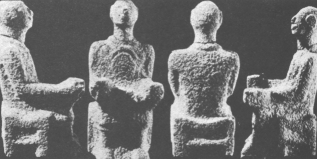
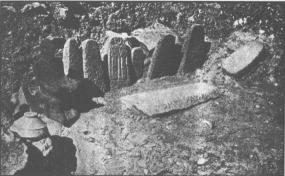
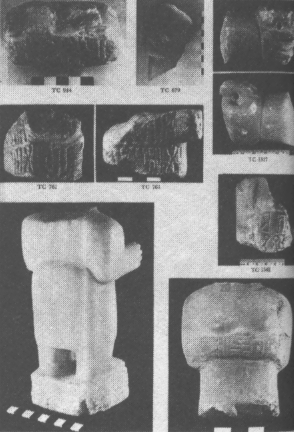
What about Arabia? As pointed out by Professor Coon, "Muslims are notoriously loathe to preserve traditions of earlier paganism and like to garble what pre-Islamic history they permit to survive in anachronistic terms" (Carleton S. Coon, Southern Arabia, Washington DC, Smithsonian, 1944, p.398).
During the 19th century, Arnaud, Halevy, and Glaser went to southern Arabia and dug up thousands of Sabean, Minaean, and Qarabanian inscriptions which were subsequently translated.
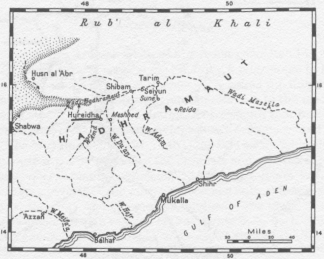
In the 1940's, archaeologists G. Caton Thompson and Carleton S. Coon made some amazing discoveries in Arabia. During the 1950's, Wendell Phillips, W.F.Albright, Richard Bower, and others excavated sites Qataban, Timna, and Marib (the ancient capital of Sheba).
Thousands of inscriptions from walls and rocks in northern Arabia have also been collected. Reliefs and votive bowls used in worship of the "daughters of Allah" have also been discovered. The three daughters, Al-Lat, Al-Uzza, and Manat are sometimes depicted together with Allah the moon-god represented by a crescent moon above them (North Arabian archaeological finds concerning Al-Lat are discussed in: Isaac Rabinowitz, Aramaic Inscriptions of the Fifth Century, JNES, XV, 1956, pp.1-9; Another Aramaic Record of the North Arabian goddess Han'Llat, JNES, XVIII, 1959, pp.154-55; Edward Linski, The Goddess Atirat in Ancient Arabia, in Babylon and in Ugarit: Her Relation to the Moon-god and the Sun-goddess, Orientalia Lovaniensia Periodica, 3:101-9; H.J.Drivers, Iconography and Character of the Arab Goddess Allat, found in Études Preliminaries Aux Religions Orientales Dans L'Empire Roman, ed. Maarten J. Verseren, Leiden, Brill, 1978, pp.331-51).
The archaeological evidence demonstrates that the dominant religion in Arabia was the cult of the moon-god. The Old Testament consistenly rebuked the worship of the moon-god (e.g. Dt.4:19; 17:3; 2 Ki.21:3,5; 23:5; Jer.8:2; 19:13; Zeph.1:5). When Israel fell into idolatry, it was usually to the cult of the moon-god. In Old Testament times, Nabonidus (555-539 BC), the last King of Babylon, built Tayma, Arabia, as a centre of moon-god worship. Segall stated: "South Arabia's stellar religion has always been dominated by the Moon-god in various variations" (Berta Segall, The Iconography of Cosmic Kingship, the Art Bulletin, vol.xxxviii, 1956, p.77). Many scholars have also noticed that the moon-god's name, Sín, is a part of such Arabic words as "Sinai", the "wilderness of Sîn", and so forth.
When the popularity of the moon-god waned elsewhere, the Arabs remained true to their conviction that the moon-god was the greatest of all gods. While they worshipped 360 gods at the Kabah in Mecca, the moon-god was the chief deity. Mecca was in fact built as a shrine for the moon-god. This is what made it the most sacred site of Arabian paganism.
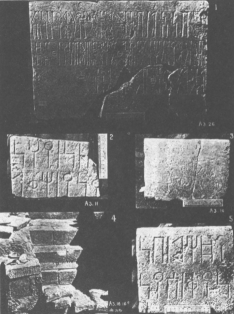
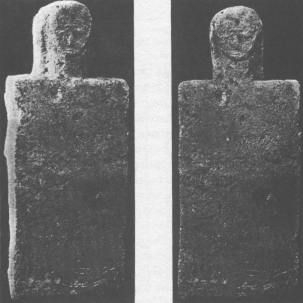
In 1944, G. Caton Thompson revealed in her book, The Tombs and Moon Temple of Hureidah, that she had uncovered a temple of the moon-god in southern Arabia (see map above). The symbols of the crescent moon and no less than 21 inscriptions with the name Sîn were found in this temple (see above left). An idol which is probably the moon-god himself was also discovered (see above right). This was later confirmed by other well-known archaeologists (See Richard Le Baron Bower Jr. and Frank P. Albright, Archaeological Discoveries in South Arabia, Baltimore, John Hopkins University Press, 1958, p.78ff; Ray Cleveland, An Ancient South Arabian Necropolis, Baltimore, John Hopkins University Press, 1965; Nelson Gleuck, Deities and Dolphins, New York, Farrar, Strauss and Giroux, 1965).
The temple reveals that the temple of the moon-god was active even in the Christian era. Evidence gathered from both North and South Arabia demonstrate that moon-god worship was clearly active even in Muhammad's day and was still the dominant cult.
According to numerous inscriptions, while the name of the moon-god was Sîn, his title was al-ilah, "the deity", meaning that he was the chief of high god among the gods. As Coon pointed out, "The God Il or Ilah was originally a phase of the Moon-God" (Coon, Southern Arabia, p.399).
The moon-god was called al-ilah, the god, which was shortened to Allah in pre-Islamic times. The pagan Arabs even used Allah in the names they gave to their children. For example, both Muhammad's father and uncle has Allah as part of their names. The fact that they were given such names by their parents proves that Allah was the title for the moon-god even in Muhammad's day. Professor Coon says, "Similarly, under Muhammad's tutelage, the relatively anonymous Ilah, became Al-Ilah, The God, of Allah, the Supreme Being" (Ibid.).
This fact answers the questions: "Why is Allah never defined in the Quran?" and "Why did Muhammad assume that the pagan Arabs already knew who Allah was?"
Muhammad was raised in the religion of the moon-god Allah. But he went one step further than his fellow pagan Arabs. While they believed that Allah the moon-god was the greatest of all gods and the supreme deity in the pantheon of deities,Muhammad decided that Allah was not only the greatest god but the only God.
In effect he said, "Look, you already believe that the moon-god Allah is the greatest of all gods. All I want you to do is accept the idea that he is the only god. I am not taking away the Allah you already worship. I am only taking away his wife and his daughters and all the other gods."
This is seen from the fact that the first point of the Muslim creed is not "Allah is great" but "Allah is the greatest" - he is the greatest among the gods. Why would Muhammad say that Allah is the greatest except in a polytheistic (many gods) context? The Arabic word is used to contrast the greater from the lesser.
That this is true is seen from the fact that the pagan Arabs never accused Muhammad of preaching a different Allah than the one they already worshipped. Thus "Allah" was the moon-god according to the archaeological evidence.
Muhammad thus attempted to have it both ways. To the pagans, he said that he still believed in the moon-god Allah. To the Jews and the Christians he said that Allah was their God, too. But both the Jews and the Christians, who worshipped Yahweh, knew better and they rejected his god Allah as a false god.
Al-Kindi, one of the early Christian apologists against Islam, pointed out that Islam and its god Allah did not come from the Bible but from the paganism of the Sabeans. They did not worship the God of the Bible but the moon-god and his daughters al-Uzza, al-Lat, and Manat (Three Early Christian-Muslim Debates, ed. by N.A.Newman, Hatfield, PA, IBRI, 1994, pp.357, 413, 426).
Dr. Newman concludes his study of the early Christian-Muslim debates by stating, "Islam proved itself to be ... a separate and antagonistic religion which had sprung up from idolatry" (Ibid., p.719). Islamic scholar Caesar Farah concluded, "There is no reason, therefore, to accept the idea that Allah passed to the Muslims from the Christians and the Jews" (Caesar Farah, Islam: Beliefs and Observances, New York, Barrons, 1987, p.28).
The Arabs worshipped the moon-god as a supreme deity. But that was not biblical monotheism. While the moon-god was greater than all the other gods and goddesses, this was still a polytheistic pantheon of deities. Now that we have the actual idols of the moon-god, it is no longer possible to avoid the fact that Allah was a pagan god in pre-Islamic times.
Is it any wonder that the symbol of Islam is the crescent moon? That a crescent moon sits on top of their mosques and minarets? That a crescent is found on the flags of Islamic nations? That the Muslims fast during the month which begins and ends with the appearance of the crescent moon in the sky?
Conclusion
The pagan Arabs worshipped the moon god Allah by praying toward Mecca several times a day; making a pilgrimage to Mecca; running around the temple of the moon-god called the Kabah; kissing the black stone; killing an animal in sacrifice to the moon-god; throwing stones at the devil; fasting for the month that begins and ends with the crescent moon; giving alms to the poor, and so on.
The fact that the Muslims worship only one god - are monotheists - does not prove that the god they worship is the True God. A similar pagan "reformation" occurred in ancient Egypt when Pharaoh Akhenaton decided to become a monotheist by making the sun-god Aton the one and only true god of Egypt, persecuting and outlawing worship of all the other gods of his nation.
There are four interesting parallels with Islam here: (a) Akhenaton made the male sun-god the one and only god of Egypt, while (b) Muhammad made the male moon-god the one and only god of the Arabs. Neither god remotely resembled Yahweh, the God of the Bible, both being pagan deities borrowed from polytheistic religions. And there is a third parallel: (c) Though technically monotheistic, in practice Akhenaton remained a god himself. Though never calling himself a "god", Muhammad certainly accrued many of the attributes of godly power as we shall see in subsequent articles. Finally, (d) Akhenaton used as a symbol for his god the Ankh Cross consisting of a solar disk atop a Tau cross, Muhammad retained for Islam the pagan crescent moon symbol of the moon-god Allah.
Is this all a fanciful, far-fetched conclusion? Is all the vast array of scholarly information available on Allah simply a conspiracy by evil Westerners to discredit Islam? Or might what you have read be the truth? Are you honest enough to continue researching the origins of Islam further? And most importantly, are you honest enough to admit that you might be wrong and that the truth about God lies elsewhere?
My purpose in this article has not been to prove Christianity but simply to examine Islam's roots and to see if the "official version" is believable. What we must not do is try to cover up the deficiencies of our own religion by attacking another one. The two issues muct be kept separate so as not to confuse the issue. This requires self-control above all else. It means keeping passions checked we calmly investigate the facts. Hot-headed people do not tend to find the truth because they are too blinded by their own chaotic feelings.
May Yahweh, the God of Abraham, Isaac and Jacob, and all the biblical prophets, and of Yah'shua (Jesus) Himself, the Christ ,bless you and guide you in the way of truth. Amen.